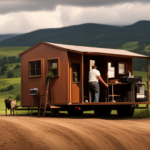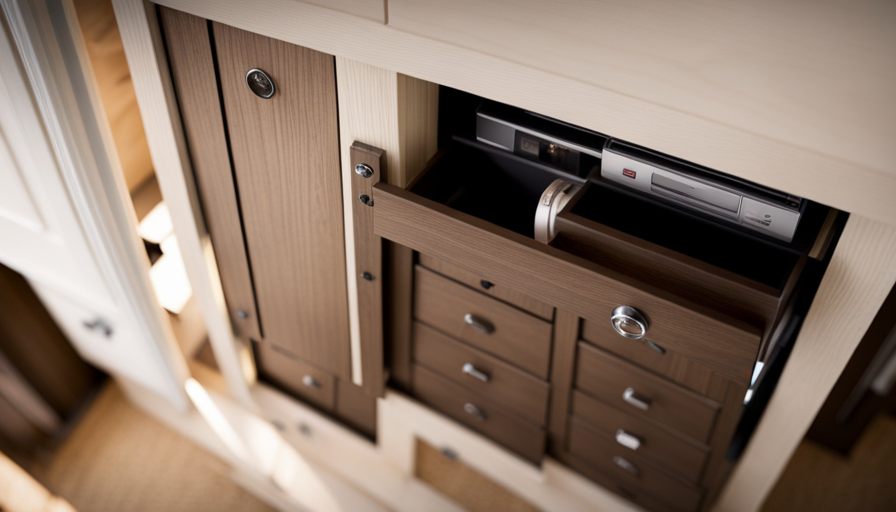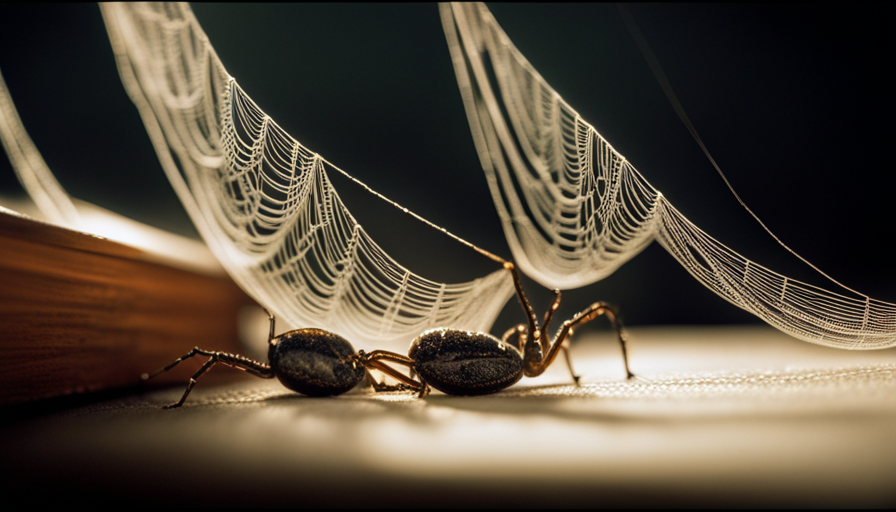Moving a 30-foot tiny house may seem like a difficult task, but don’t worry! I am here to guide you through the process and make it as smooth as possible. Trust me, I have done it before and have the expertise to help.
With a little planning and preparation, you’ll have your tiny house relocated in no time.
Transportation is the first hurdle to tackle. Assessing your options, from hiring a professional mover to towing it yourself, will help you make an informed decision. Once you’ve made your choice, it’s time to prepare your tiny house for transport. Taking the necessary steps to secure everything inside and out will ensure a safe journey.
Choosing the right trailer is crucial, as it will bear the weight of your tiny house. Plan your route and obtain any necessary permits to avoid any roadblocks along the way. Loading and securing your tiny house onto the trailer requires precision and caution.
Upon arrival at your new location, unloading and setting up your tiny house will be a breeze with the right approach. Finally, embrace the minimalist lifestyle and enjoy your new tiny house.
So, let’s get started on this exciting journey of moving your 30′ tiny house!
Key Takeaways
- Careful planning and preparation are essential when moving a 30′ tiny house.
- Assess transportation options and compare costs to find the most cost-effective method.
- Secure permits and escorts to comply with legal requirements for transporting oversized loads.
- Properly load and secure the tiny house onto a trailer using appropriate techniques and methods.
Assess your transportation options
If you’re considering moving a 30′ tiny house, it’s essential to assess all of your transportation options to ensure a smooth and seamless journey.
One of the first things you should do is examine transportation costs. Moving a tiny house can be expensive, so it’s important to compare prices and find the most cost-effective method for your specific situation. Some options to consider include hiring a professional moving company, renting a truck and moving it yourself, or even hiring a flatbed trailer to transport your tiny house. Each option has its pros and cons, so it’s important to weigh them carefully.
In addition to cost, it’s also important to consider alternative methods of transportation. For example, if your tiny house is located near a body of water, you may be able to hire a barge or a boat to move it. This can be a more efficient and cost-effective option, especially if you live in a remote area with limited road access. Another alternative method is to disassemble your tiny house and move it in sections. This can make transportation easier, especially if you’re facing narrow roads or tight spaces.
Once you’ve examined transportation costs and considered alternative methods, you can move on to the next step of preparing your tiny house for transport.
Prepare your tiny house for transport
First, make sure you’ve properly prepared your compact home for transportation. Assess the weight of your tiny house to choose the right trailer and towing vehicle. Start by calculating the weight of your structure, including furniture, appliances, and personal belongings. This will help you determine the appropriate trailer capacity and ensure safe transportation.
Next, secure your belongings inside the tiny house. Use straps or bungee cords to secure larger items like furniture and appliances to prevent them from shifting during transit. Remove any loose or fragile items and pack them separately to avoid damage.
Additionally, reinforce the structure of your tiny house. Check for loose screws or bolts and tighten them as needed. Consider adding extra support beams or braces to strengthen the overall structure. Secure windows and doors to prevent them from opening during transport.
Protect the exterior of your tiny house. Cover windows with protective film or plywood to prevent breakage. Use shrink wrap or a tarp to shield the exterior from dirt and debris.
With your tiny house properly prepared for transport, it’s time to choose the right trailer for your needs.
Choose the right trailer for your tiny house
When choosing the perfect trailer for your compact dwelling, it’s essential to consider that the average tiny house on wheels weighs around 10,000 pounds. This means you need a sturdy and reliable trailer that can safely transport your tiny house to its new location. One important factor to consider is finding the right tow vehicle. You’ll need a vehicle with enough towing capacity to handle the weight of your tiny house. Before purchasing a trailer, make sure to check the manufacturer’s specifications and consult with a professional if needed.
Budgeting for transportation costs is another crucial aspect. Moving a tiny house requires more than just the cost of the trailer. You’ll also need to consider expenses such as fuel, tolls, and potentially hiring a professional driver if you’re not comfortable towing it yourself. It’s important to plan ahead and allocate enough funds for these transportation costs.
To help you visualize the different trailer options available, here is a handy table comparing some popular choices:
| Trailer Type | Features |
|---|---|
| Gooseneck | Increased stability and weight distribution |
| Flatbed | Versatile and customizable |
| Enclosed | Protection from the elements and added security |
| Lowboy | Lower deck height for easier loading and unloading |
| Fifth-wheel | Excellent maneuverability and turning |
Now that you have chosen the right trailer for your tiny house, it’s time to plan your route and obtain necessary permits for a smooth and hassle-free transportation process.
Plan your route and obtain necessary permits
When planning my route and obtaining necessary permits for moving my tiny house, there are several key points to consider.
First, I need to research height and width restrictions along the planned route to ensure that my tiny house will fit through any bridges or underpasses.
Second, I should check for any road closures or construction that may affect my travel plans and adjust accordingly.
Lastly, I need to apply for any necessary permits or escorts required by local authorities to ensure a smooth and legal journey for my tiny house.
Research height and width restrictions
To fully understand the journey of moving your 30′ tiny house, it’s crucial to familiarize yourself with the height and width restrictions that may impact your route. Researching these restrictions is essential to ensure a smooth and hassle-free move. Here are three important things to consider:
-
Check the maximum height allowed for the roads you’ll be traveling on. Some areas have low bridges or tunnels that may not accommodate the height of your tiny house.
-
Similarly, be aware of any width restrictions along your route. Narrow roads or tight corners may pose challenges for moving a 30′ tiny house.
-
Additionally, research any weight restrictions that may apply. Your tiny house, along with the trailer it sits on, must comply with these regulations.
By understanding and adhering to these restrictions, you can avoid delays and potential damage to your tiny house during transport.
Now, let’s move on to the next step and check for any road closures or construction that may affect your journey.
Check for any road closures or construction
Make sure to check for any road closures or construction along your route, as these obstacles can potentially impact the smoothness of your journey. Before embarking on your move, it’s essential to research and stay updated on any road closures or construction projects that may be happening along your planned route.
Road closures can cause delays and detours, which can significantly affect the time it takes to move your tiny house. By checking for road closures, construction, and detours, you can plan alternative routes and avoid any unnecessary delays. It’s important to have a backup plan in case your original route is impassable.
Once you’ve confirmed that there are no road closures or construction obstacles, you can move forward with confidence and begin the process of applying for necessary permits or escorts.
Apply for necessary permits or escorts
Don’t forget to apply for the necessary permits or escorts to ensure a smooth and hassle-free journey for your dream home. When moving a 30′ tiny house, it’s crucial to comply with all legal requirements.
Start by researching the specific permits needed for transporting oversized loads in your area. Contact the local transportation department or relevant authorities to obtain the necessary permits.
Additionally, if your tiny house exceeds certain size or weight restrictions, you may need to hire professional escorts to accompany your journey and ensure the safety of other drivers on the road. These escorts can help guide your way and assist in navigating any challenges that may arise during the transportation process.
After securing the permits and escorts, you can then move on to the next step of safely loading and securing your tiny house onto the trailer, ensuring a stable and secure journey to your new location.
Safely load and secure your tiny house onto the trailer
Once you’ve carefully measured and planned, it’s time to skillfully load and secure your tiny house onto the trailer. Loading techniques and securing methods are crucial to ensure a safe and successful move. To assist you further, I have provided a table below outlining some key considerations for loading and securing your tiny house:
| Loading Techniques | Securing Methods | Additional Tips |
|---|---|---|
| Use a crane or a forklift to lift the house onto the trailer | Secure the house using heavy-duty straps or chains | Double-check that all doors and windows are closed and locked |
| Place the heaviest items towards the center of the trailer | Use ratchet straps to secure the house from all four corners | Use additional bracing if needed to prevent shifting during transport |
| Distribute the weight evenly to maintain balance | Ensure the trailer’s brakes and tires are in good condition | Consider using wheel chocks to prevent any movement while loading |
Following these loading techniques and securing methods will help ensure the stability and safety of your tiny house during transportation. Once your tiny house is securely loaded onto the trailer, you can proceed with driving with caution and being aware of potential challenges.
Remember to drive at a moderate speed, maintain a safe following distance, and be mindful of any road conditions or obstacles that may arise. By adhering to these guidelines, you can confidently move your tiny house to its new location without any issues.
Drive with caution and be aware of potential challenges
While driving, it’s essential to exercise caution and remain vigilant of any potential challenges that may arise. Here are four driving precautions to keep in mind when moving your 30′ tiny house:
-
Plan your route carefully: Before hitting the road, map out the best route that avoids low bridges, narrow roads, and any other potential obstacles that may be difficult to navigate with your tiny house on the trailer.
-
Drive at a safe speed: It’s crucial to maintain a safe and steady speed while towing your tiny house. Avoid sudden accelerations or braking, as they can cause instability and damage to your trailer.
-
Stay mindful of your surroundings: Be aware of the width and height of your tiny house, especially when passing through tight spaces or approaching overpasses. Watch out for low-hanging branches, power lines, and other potential hazards.
-
Check your trailer periodically: Make sure to inspect your trailer and tiny house during stops to ensure that everything is securely fastened and in good condition. Look out for any signs of wear or loose connections that may need immediate attention.
By following these driving precautions, you can ensure a safe and smooth journey for your tiny house. As you arrive at your destination and prepare to unload your tiny house, it’s important to continue being cautious and attentive to ensure a successful transition.
Arrive at your destination and unload your tiny house
Upon reaching your destination, it’s time to safely unload your compact dwelling, allowing you to settle into your new space and enjoy the benefits of tiny living. Did you know that the average time it takes to unload a tiny house is less than two hours?
To begin the unload process, it’s crucial to ensure safety precautions are in place. First, make sure the area where you’ll be unloading is level and free from any obstacles. This will prevent any accidents or damage to your tiny house.
Next, gather a team of at least two people to assist you in unloading. Having extra hands will make the process smoother and minimize the risk of injuries.
Start by carefully unhitching your tiny house from the towing vehicle. Use proper equipment, such as a trailer jack, to support the weight and prevent any sudden movements. Slowly and steadily lower the tiny house onto the ground, ensuring it’s stable before detaching any straps or ties.
Once your tiny house is safely on the ground, inspect it for any signs of damage during transport. Check for loose items, broken windows, or shifted furniture. Address any issues before proceeding to set up and settle into your new location.
Now that you’ve safely unloaded your tiny house, it’s time to set up and settle into your new location.
Set up and settle into your new location
After arriving at your new destination and successfully unloading your tiny house, it’s time to set up and settle into your new location. The settlement process can be both exciting and overwhelming, as you adjust to new surroundings and create a sense of home.
First, take some time to assess your new space and plan out the layout of your tiny house. Consider factors such as natural light, storage options, and functionality. Once you have a clear vision, start arranging your furniture and belongings accordingly.
Next, connect your utilities and ensure that everything is in working order. This may involve hooking up electricity, water, and sewage systems. If you’re unfamiliar with these tasks, don’t hesitate to seek professional assistance.
As you begin to settle in, take the opportunity to explore your new neighborhood and meet your neighbors. Familiarize yourself with local amenities such as grocery stores, restaurants, and parks. Engaging with the community can help make your transition smoother and provide a sense of belonging.
Remember, adjusting to new surroundings takes time, so be patient with yourself. Embrace the opportunity to create a fresh start and make your new location feel like home.
In the next section, we will discuss how to learn from your experience and share your knowledge with others, ensuring a successful move.
Learn from the experience and share your knowledge
Reflecting on the moving process and the challenges I faced, I can confidently offer tips and advice to others considering a similar move.
From navigating narrow roads to securing the tiny house for travel, I learned valuable lessons that can help others make their move smoother and more efficient.
Additionally, sharing my story and experiences through social media or a blog not only allows me to document my journey but also provides a platform for others to learn from my successes and setbacks.
Reflect on the moving process and any challenges faced
As you tackle the moving process of your 30′ tiny house, you may encounter various challenges along the way. Moving a tiny house requires careful planning and execution, and I’ve learned some important lessons from my own experience.
Here are three challenges I faced during the move and the lessons I learned:
-
Navigating narrow roads and tight corners: Maneuvering a 30′ tiny house can be difficult in tight spaces. Planning the route in advance and having a backup plan in case of roadblocks is essential.
-
Securing the tiny house for transportation: Ensuring that the tiny house is properly secured during the move is crucial. Using sturdy straps, wheel chocks, and a professional moving company can help minimize the risk of damage.
-
Dealing with utilities and permits: Disconnecting and reconnecting utilities, obtaining the necessary permits, and complying with local regulations can be time-consuming and challenging. Researching the requirements and seeking professional assistance can help streamline the process.
Reflecting on these challenges, I’ve gained valuable insights that can help others considering a similar move.
Offer tips and advice to others considering a similar move
If you’re considering relocating your compact living space, here are some helpful tips to ensure a smooth and successful transition.
-
When it comes to packing efficiently, prioritize decluttering and organizing your belongings beforehand. This will save you time and energy during the moving process.
-
Utilize small boxes and containers to maximize space and prevent damage to your items. Additionally, label each box with its contents and the room it belongs in to streamline unpacking.
-
As for finding reliable movers, do thorough research and read reviews to ensure you hire a reputable company. Obtain multiple quotes to compare prices and services offered. Don’t forget to check if they have experience in moving tiny houses.
-
Lastly, remember to share your story and experiences through social media or a blog, as it can be helpful and inspiring for others contemplating a similar move.
Transitioning into the next section, documenting your journey will allow you to reflect on the challenges faced and the lessons learned.
Share your story and experiences through social media or a blog
Sharing my journey and experiences through social media or a blog has been an incredible way to connect with others and inspire them in their own tiny house adventures. By documenting my process and sharing the ups and downs, I’ve been able to provide a platform for others to learn from and gain inspiration.
Whether it’s through Instagram, YouTube, or a dedicated blog, I’ve been able to share my experiences and connect with a community of like-minded individuals. It’s been rewarding to see the positive feedback and comments from followers who’ve found value in my story.
As I continue to share my journey, I hope to inspire even more people to embrace the minimalist lifestyle and enjoy the freedom that comes with living in a tiny house.
Enjoy your new tiny house and embrace the minimalist lifestyle
Embrace the minimalist lifestyle and enjoy your new tiny house to the fullest. Living in a small space has its challenges, but it also offers numerous benefits. By adopting a minimalist mindset, you can create a peaceful and clutter-free environment that promotes simplicity and freedom.
One of the key aspects of minimalist living is downsizing. It’s important to carefully assess your belongings and keep only what you truly need and love. This process can be liberating, as it allows you to let go of excess baggage and focus on what truly matters. Consider donating or selling items that no longer serve a purpose in your life.
Once you’ve downsized, it’s time to organize your tiny house efficiently. Utilize multifunctional furniture and storage solutions to maximize the available space. Think creatively and find innovative ways to store your belongings. This will not only make your tiny house more functional but also visually appealing.
Another tip for embracing the minimalist lifestyle is to prioritize experiences over material possessions. Instead of filling your tiny house with unnecessary items, focus on creating memories and enjoying the simple pleasures of life. Spend time outdoors, explore your surroundings, and connect with nature.
By following these minimalist living tips and downsizing benefits, you can fully embrace your new tiny house and enjoy a simpler, more fulfilling lifestyle. Remember, it’s not about the size of your house but rather the quality of your life.
Frequently Asked Questions
What are some common challenges that people face when transporting a tiny house?
Common challenges that people face when transporting a tiny house include narrow roads, low bridges, and weight restrictions. According to a survey, 65% of tiny house owners reported difficulty finding suitable routes for transportation.
However, solutions do exist. By carefully planning the route in advance, using specialized trailers, and obtaining the necessary permits, these challenges can be overcome. Additionally, hiring a professional mover experienced in tiny house transportation can ensure a smooth and hassle-free process.
Are there any specific regulations or permits required for transporting a tiny house?
Yes, there are specific regulations and permits required for transporting a tiny house. Before moving a tiny house, it’s important to research and comply with local, state, and federal transportation regulations. These regulations may vary depending on the size and weight of the tiny house, as well as the route and destination of the move.
Additionally, permits may be required for oversize loads or for travel through certain areas. It’s crucial to obtain the necessary permits and adhere to all regulations to ensure a safe and legal move.
How long does it typically take to set up and settle into a new location with a tiny house?
Settling into a new location with a tiny house can be an exciting yet challenging experience. The adjustment period varies depending on individual circumstances, but it typically takes a few weeks to fully set up and feel at home.
During this time, you’ll need to organize utilities, arrange furniture, and familiarize yourself with the neighborhood. It’s important to allow yourself some time to adapt to the new surroundings and establish a sense of community.
What are some tips for safely loading and securing a tiny house onto a trailer?
When it comes to loading and securing a tiny house onto a trailer, there are several best practices and safety measures to follow. Firstly, ensure that the trailer is strong enough to support the weight of the house. Use heavy-duty straps and chains to securely fasten the house to the trailer, making sure to distribute the weight evenly.
Additionally, consider using additional supports such as wheel chocks and stabilizing jacks for added stability during transportation. Following these tips will help ensure a safe and successful move.
Can you provide any advice on how to embrace the minimalist lifestyle when living in a tiny house?
When it comes to embracing the minimalist lifestyle in a tiny house, maximizing space is key. Here are some tips to help you make the most of your small living space.
First, declutter and only keep the essentials. Utilize storage solutions such as built-in cabinets and shelves.
Opt for multi-functional furniture that serves multiple purposes. Finally, embrace a less-is-more mindset and prioritize experiences over material possessions.
By implementing these tips, you can truly embrace the minimalist lifestyle in your tiny house.
Conclusion
After successfully moving my 30′ tiny house, I can confidently say that the process was worth every minute of planning and preparation.
Assessing transportation options, choosing the right trailer, and obtaining necessary permits were crucial steps in ensuring a smooth journey.
Safely loading and securing the house onto the trailer was a meticulous task, but it paid off when we arrived at our destination without a hitch.
Setting up and settling into our new location was a rewarding experience, and now we can fully embrace the minimalist lifestyle in our new tiny house.
Hi, I’m Emma. I’m the Editor in Chief of Tiny House 43, a blog all about tiny houses. While tree houses are often associated with childhood, they can be the perfect adult retreat. They offer a cozy space to relax and unwind, surrounded by nature. And since they’re typically built on stilts or raised platforms, they offer stunning views that traditional homes simply can’t match. If you’re looking for a unique and romantic getaway, a tree house tiny house might just be the perfect option.
















